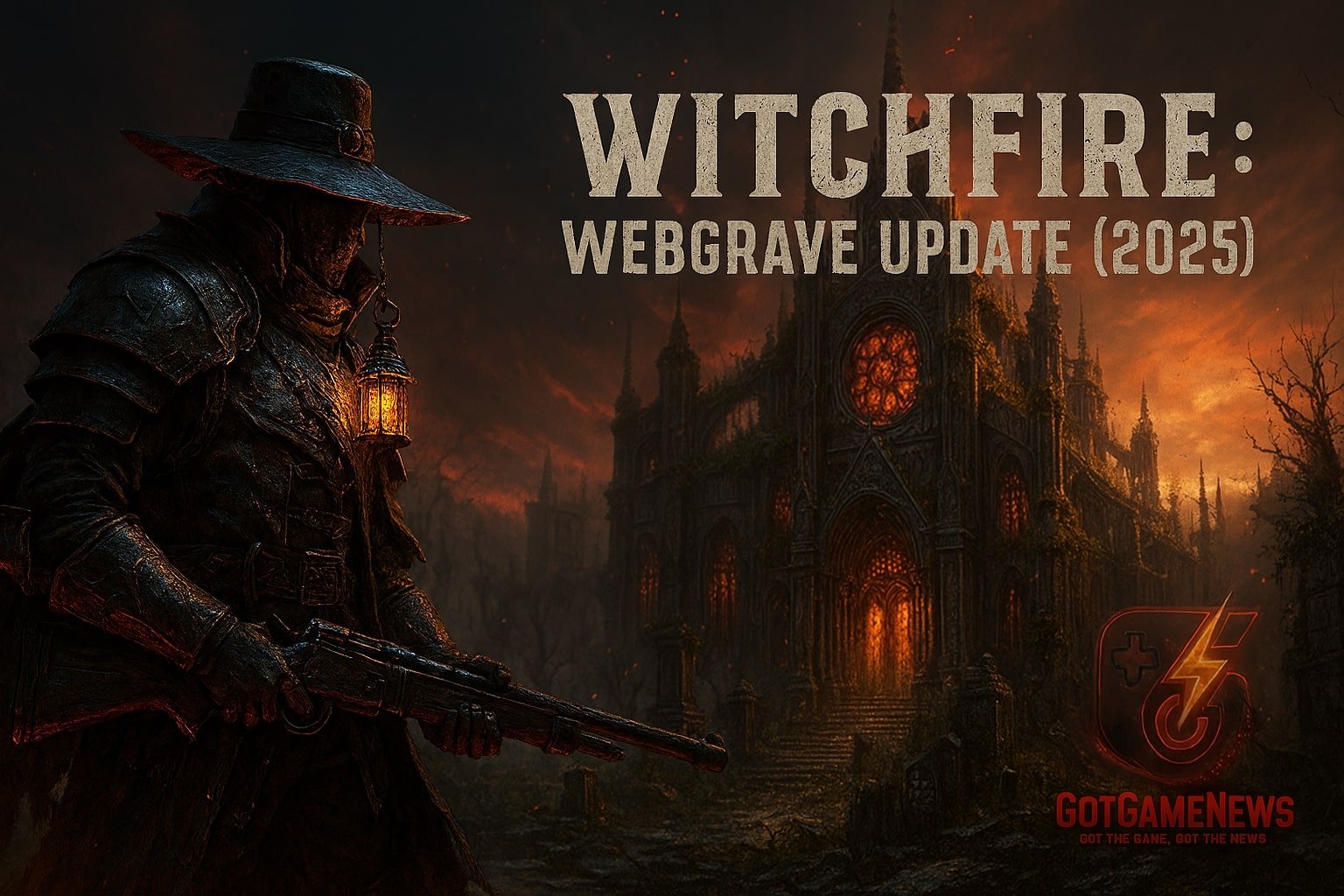Witchfire launched like a fever dream: dark, stylish, and tantalizingly cruel. A high-concept FPS-RPG from The Astronauts (the indie crew behind The Vanishing of Ethan Carter), it offered gunplay with real teeth—but felt more like a glorified arena roguelite than the gothic looter-shooter it promised to become.
Enter Webgrave, the game’s July 28 mega-update. It’s not just content—it’s reconstruction. We’re talking a new biome, new weapons, and a reshaped soul. What once felt like a twitchy loot treadmill now bristles with systemic depth. This isn’t Witchfire 1.1. It’s Witchfire: Reforged.
- 🎮 Gameplay – Built to Break, Rebuilt to Think
- 🎨 Graphics, Sound & Vibe – Medieval Doom with Baroque Fangs
- ⚙️ Performance – Solid Bones, Occasional Squeaks
- 📖 Story & Theme – Lore as a Weapon
- ✅ Final Verdict – Webgrave Is Witchfire Unleashed
🎮 Gameplay – Built to Break, Rebuilt to Think
🧠 Workshop 2.0: Goodbye RNG, Hello Syndicate Brain Rot
Previously, unlocking gear in Witchfire meant praying to the RNG gods and grinding until something pretty dropped. Now? You’re handed a tech tree inspired by 1993’s Syndicate: branching paths of weapons, spells, passives, and traps. Research requires materials and “gnosis”—a new resource tied to your in-game knowledge and progression.
It makes every upgrade feel earned, not handed. You’re building your character like a conspiracy diagram. It’s wickedly satisfying.
🔫 New Weapons – From Wallhacks to Cowboy Carnage
- The Oracle: A long-range sniper that can shoot through walls. Not metaphorically. You literally tag an enemy’s outline and blast them into dust from safety. It’s like seeing through the Matrix—especially hilarious in tight crypt hallways.
- The Nemesis: A lever-action rifle that spits out crits like a six-shooter possessed. Deadly at midrange, and it reloads with cowboy flair. It’s the gun Jesse McCree would pick if he were raised by plague doctors.
Combined with the game’s dynamic spell system (which still slaps), these weapons elevate the loop from twitch shooter to tactical chessboard.
🧬 Stats Overhaul – Flesh, Faith, and the Return of Buildcraft
Gone are the old-school RPG tropes of “Strength” or “Dex.” Webgrave introduces six original stats—Flesh, Blood, Mind, Witchery, Arsenal, and Faith—each with three substats that dictate everything from health regen to reload speed to spell capacity.
It’s Bloodborne-level elegant. Want to tank hits and heal through pain? Flesh + Blood. Want a glass cannon build that detonates time itself? Witchery + Mind. The best part? You feel all of it in real time. This isn’t passive math—it’s gameplay gravity.
📿 The Rosary – Witchfire’s Runes, But Meaner
If the Workshop is your toolbox and stats are your skeleton, the Rosary system is your soul. These relics are powerful modifiers—like increased spell charge, total fire resistance, or vampiric melee—but they come with build requirements. Think Bloodborne’s Caryll Runes but tailored to your stat path.
Slotting the perfect rosary for your build becomes an obsession. It’s also where Witchfire finally embraces player identity. You’re not just “a gunman in a forest.” You’re The Mind-Witch of the Blighted Bastion, or The Flesh-Knight of Hollow Moor.
🔥 Gnosis – Knowledge as Power, and Pain
Webgrave adds layered “Gnosis” tiers—effectively difficulty modifiers with a lore twist. Higher Gnosis reveals secret loot areas and deeper environmental storytelling but also ratchets enemy AI and spawns. The brilliance? Gnosis isn’t just “hard mode.” It’s a philosophical tax on curiosity.
In other words: if you dare to know, you’d better be ready to suffer.
🎨 Graphics, Sound & Vibe – Medieval Doom with Baroque Fangs
The new Webgrave region is a rot-slick cathedral city called “Blighted Town.” It’s like Yharnam and Quake had a cursed lovechild. Gothic arches crumble under blood rains; fungal growths clutch at dead churches. It’s gorgeous in that way only decay can be.
Enemy design remains deliciously grotesque—floating crusaders, screaming martyrs, and haunted relics that twitch with holy contempt. Sound design sings here: the Oracle’s wall-piercing shot whispers, then thunders, like a sin finding its mark.
Music, still dynamic and percussive, now shifts tempo as you ramp Gnosis levels. It’s not background noise—it’s threat made audible.
⚙️ Performance – Solid Bones, Occasional Squeaks
Running on a mid-tier RTX 3060 rig, performance was mostly smooth at 60-90 FPS, even on Gnosis 3 chaos. Load times remain snappy thanks to Unreal Engine’s foundation. That said, occasional pathfinding glitches and UI bugs still crop up—most notably in the new Workshop menus.
But The Astronauts have built a reputation for fast patchwork, and early player reports on Steam Deck praise solid optimization.
📖 Story & Theme – Lore as a Weapon
While Witchfire doesn’t have cutscenes or companions, its lore is everywhere—in enemy names, item descriptions, and the very architecture. Webgrave continues this with subtle environmental cues: statues clutching missing rosary beads, messages carved in plague bone.
It’s minimalist, yes, but there’s a creeping cohesion to it all. You feel like you’re peeling back heresies with every bullet.
✅ Final Verdict – Webgrave Is Witchfire Unleashed
Witchfire was always a good shooter. Webgrave makes it a great RPG. This update retools the entire progression arc into a machine that rewards cunning, courage, and commitment. It turns a promising Early Access title into something worthyof its haunting aesthetic.
But it’s not for everyone. The update introduces complexity that may baffle casual dabblers. And yes, it’s still in Early Access—so some systems feel sharp-edged and experimental.
But for players who want buildcraft that matters, weapons with personality, and a world that dares you to master it, Webgrave is the update that finally makes Witchfire worth evangelizing.
9/10 – A brutal, baroque triumph. Not just Witchfire’s biggest update—its best version yet.






1 Comment